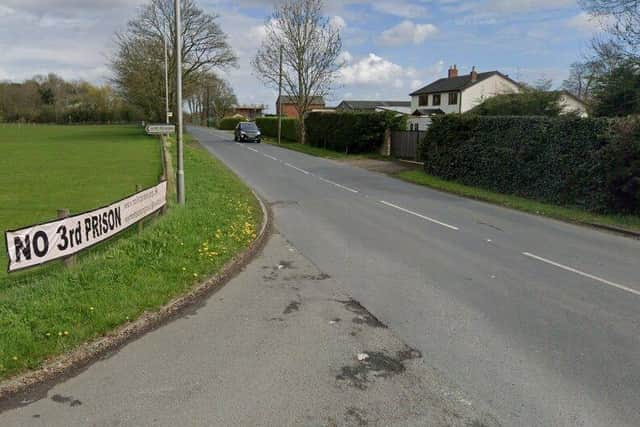Country lane in Chorley will see 'an HGV every minute-and-a-half' if Ulnes Walton prison is built
and live on Freeview channel 276
The statistic was presented to the ongoing public inquiry into the proposed jail in Ulnes Walton which also heard that there were significant swathes of Ulnes Walton Lane along which articulated HGVs would be unable to pass in opposite directions - and so would be forced into reverse.
Transport expert Kevin Riley, appearing as a witness for Chorley Council - which refused the Ministry of Justice's (MoJ) bid for planning permission for the prison more than two years ago - described the situation that he said would be created on the route during construction of the lock-up as “totally unacceptable”.


Advertisement
Hide AdAdvertisement
Hide AdThe inquiry was told Mr. Riley had made a series of calculations about the potential frequency of HGV movements based on figures provided by the MoJ.
He said those numbers suggested there would typically be 10-12 HGVs travelling every hour along Ulnes Walton Lane - between the A581 Southport Road and the proposed prison site, close to the existing Garth and Wymott jails, between June 2025 and January 2027.
However, Mr. Riley noted that by applying a “logical distribution” of vehicles over the normal working day, as many as 40 HGV movements an hour might be expected.
“[That] equates to a vehicle every minute-and-a-half,” he said.
Advertisement
Hide AdAdvertisement
Hide Ad“We're talking a constant flow from…[say] half past eight in the morning through to something like 4.15[pm] of 10 HGVs every 15 minutes.”
In evidence spanning the first two days of the inquiry, on Monday and Tuesday this week, Mr. Riley stressed that the 7.5-tonne weight limit on the route meant that were it not for the fact the vehicles were accessing a site that required them to use Ulnes Walton Lane, they would not be permitted to travel on it - because it is “geometrically inadequate”.
Asked under examination by Piers Riley Smith - the barrister representing Chorley Council at the inquiry - whether he considered the road to be “suitable" for such a volume of construction traffic, Kevin Riley replied: “Not at those levels, no.”
The inquiry was also told that written evidence submitted by a transport expert for the MoJ - who will be questioned next week - showed that for 690 metres of the relevant 1.5km stretch of Ulnes Walton Lane the route was too narrow for two, 16.5-metre articulated vehicles to meet in opposing directions.
Advertisement
Hide AdAdvertisement
Hide AdAsked what it would mean in the “real world” if they nethertheless did so, Mr. Riley said: “One of them's got to reverse or find a way of getting past…[such as] going on to verges where they exist. If they don't exist, then they have basically got to start reversing down this carriageway.
“This could be a construction period during winter months when it's dark and also when there's cyclists around. So…a cyclist coming up and down this carriageway…could be caught behind the lorry that starts to reverse [and] they might have, say, a van behind them. That creates a real danger,” Mr. Riley added.
He also said that problems might occur even if just one of the HGVs crossing paths with another was articulated.
‘PERFECTLY NORMAL’
Cross-examining Mr. Riley on behalf of the MoJ, Jenny Wigley KC said there was nothing unusual about careful negotiation being needed between large vehicles on rural roads.
Advertisement
Hide AdAdvertisement
Hide Ad“There will be issues about ensuring [the HGVs] pull over if there is a pinch point,” she acknowledged.
“I live in rural Lincolnshire [and] all the time you come across a lorry that is in front of you and you have to pull on the verge or they [do] - or they pull out the way. It's not an abnormal occurrence, is it, for that to happen?" Ms. Wigley asked
Kevin Riley said that he believed it would be “abnormal in terms of the scale of impact on the road in this location”.
Pressed by Ms. Wigley on the point that such situations arose already on Ulnes Walton Lane, “albeit less frequently”, Mr. Riley conceded: “It's not something that doesn't occur occasionally at the moment.”
Advertisement
Hide AdAdvertisement
Hide AdThe inquiry has been reopened almost two years after it first sat in order to hear fresh evidence about transport issues in relation to the proposed prison. It follows the move by the Secretary of State for Levelling Up, Housing and Communities, Michael Gove, to say last year that he was “minded to” allow the MoJ’s appeal against Chorley Council’s refusal of permission - provided he could be satisfied highways issues had been “satisfactorily addressed”.
Comment Guidelines
National World encourages reader discussion on our stories. User feedback, insights and back-and-forth exchanges add a rich layer of context to reporting. Please review our Community Guidelines before commenting.